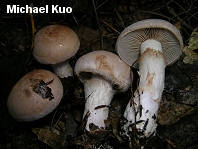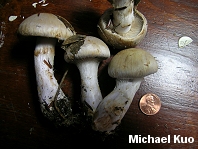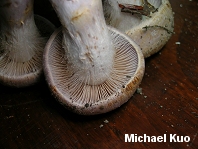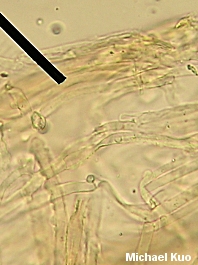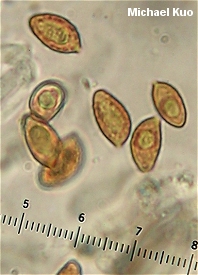| Major Groups > Gilled Mushrooms > Dark-Spored > Cortinarius > Cortinarius ophiopus |

|
Cortinarius ophiopus [Basidiomycetes > Agaricales > Cortinariaceae > Cortinarius ... ] by Michael Kuo There's a bit of a mess surrounding the proper name for this species of Cortinarius (see the discussion below if you care), but the mushroom itself is quite distinctive. It is mycorrhizal with beech, and features an orangish to brownish or buff cap that is thinly slimy and fringed with fuzziness; grayish to buff or very pale lilac gills; and a stem that is booted in floccose veil material that pulls away at the top of the boot to create a shaggy ring. As the mushroom matures the shagginess on the stem discolors brown in places, making it look a bit like Tricholoma caligatum. And, to top off the list of distinctive features, Cortinarius ophiopus smells pretty strongly of damp, moldy socks. Peck (1878) described Cortinarius ophiopus on the basis of a Maryland collection that apparently had an aberrantly long and crooked stem. In North American literature the species was subsequently treated only by Kauffman (1918, 1932), who appears to have studied the type collection (he thought Peck's dried specimens resembled dried specimens of Cortinarius corrugatus with smaller spores and stems that lacked basal bulbs) but never collected the species himself. In Europe, however, Peck's species name was taken up in the 1990's to accommodate a mushroom that looked like Cortinarius vulpinus but was associated with beech, stunk to high heaven, and had a sticky cap. Previously, European treatments had featured the mushroom in question as Cortinarius vulpinus or as Cortinarius rufoalbus. Description: Ecology: Mycorrhizal with beech; growing alone, scattered, or gregariously; fall; probably to be expected in North America throughout the range of the host tree (see the map on the linked page); apparently rare. Cap: 3-7 cm; convex, becoming broadly convex or nearly flat; thinly slimy when fresh, satiny when dry; finely hairy to finely appressed-scaly; brownish to orangish brown, orangish, or buff; the margin fuzzy with hairs from the veil. Gills: Attached to the stem, sometimes by a notch; close; creamy to grayish or very pale lilac at first, becoming rusty brown. Stem: 6-12 cm long; up to 2 cm thick; more or less equal; dry; sheathed or "booted" with copious whitish to brownish, shaggy veil material that terminates in a bent-back, hairy, ring-like apex; white above the sheath. Flesh: Whitish to grayish. Odor: Fairly strong; moldy or earthy, reminiscent of damp socks or bad cheese; intensified on drying. Chemical Reactions: KOH negative on cap surface; negative to faintly yellowish on flesh. Spore Print: Rusty brown. Microscopic Features: Spores 9-14.5 x 6-8 µ; amygdaliform; weakly to moderately verrucose. Cheilo- and pleurocystidia absent. Pileipellis a slightly gelatinized cutis of hyaline to yellowish or brownish elements that are frequently encrusted, and clamped at the septa. REFERENCES: Peck, 1878. (Saccardo, 1887; Kauffman, 1918; Kauffman, 1932; Moser, 1983 [rufoalbus]; Breitenbach & Kränzlin, 2000.) Herb. Kuo 09241112. This site contains no information about the edibility or toxicity of mushrooms. |
© MushroomExpert.Com |
|
Cite this page as: Kuo, M. (2011, December). Cortinarius ophiopus. Retrieved from the MushroomExpert.Com Web site: http://www.mushroomexpert.com/cortinarius_ophiopus.html |
